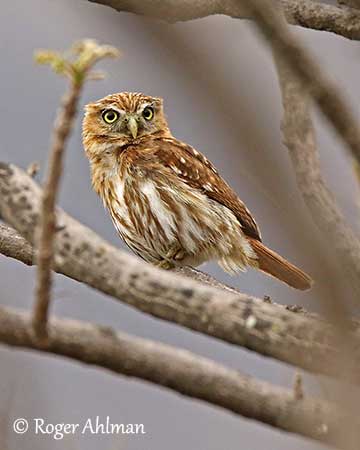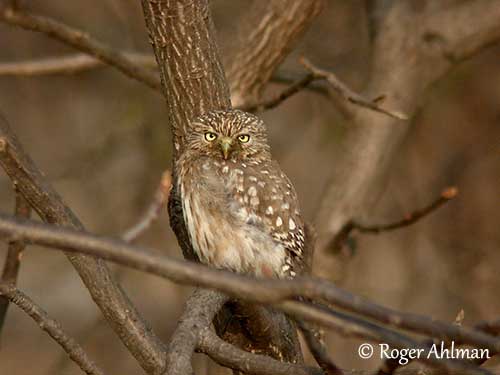
Fr: Chevêchette du Pérou
Ang: Pacific Pygmy-Owl - Peruvian Pygmy-Owl
All: Peruzwergkauz
Esp: Mochuelo Peruano
Ita: Civettina del Perù
Nd: Peruaanse Dwerguil
Sd: perusparvuggla
Photographers:
Roger Ahlman
Pbase Galleries Peru and Ecuador
John Anderson
John Anderson Photo Galleries
Dubi Shapiro
Dubi Shapiro Photo Galleries
Text by Nicole Bouglouan
Sources:
HANDBOOK OF THE BIRDS OF THE WORLD Vol 5 by Josep del Hoyo-Andrew Elliott-Jordi Sargatal - Lynx Edicions - ISBN: 8487334253
OWLS OF THE WORLD – By Claus König, Friedhelm Weick and Jan-Hendrik Becking - IBSN 978-0-7136-6548-2
Owls of the World - A Photographic Guide: Second Edition – By Heimo Mikkola – Editeur: A&C Black, 2014 – ISBN: 147290592X, 9781472905925
BIRDS OF PERU by Thomas S. Schulenberg, Douglas F. Stotz, Daniel F. Lane, John P. O’Neill, Theodore A. Parker III – Princeton University Press 2007 – ISBN: 978-0-691-13023-
Birds New to Science: Fifty Years of Avian Discoveries Par David Brewer – Editeur: Bloomsbury Publishing, 2018 – ISBN: 1472945891, 9781472945891 - 416 pages
Avibase (Denis Lepage)
Birdlife International
Mochuelo Peruano Peruvian Pygmy - Owl. Aves de Loja Ecuador
Wikipedia, the free encyclopaedia
Peruvian Pygmy-Owl or Pacific Pygmy-Owl
Glaucidium peruanum
Strigiformes Order – Strigidae Family
INTRODUCTION:
The Peruvian or Pacific Pygmy-Owl is a small Strigidae found from W Ecuador and S through W Peru and N Chile. It is now a full species.
It frequents semi-arid habitats with cacti and scattered trees, semi-open woodland, cultivated areas with large trees, and locally urban parks. It may occur up to 3,000 metres of elevation.
It typically feeds on insects and various arthropods, and also takes small birds, small mammals and other small vertebrates.
This species is a cavity-nester, using a variety of holes, both in cacti and trees, including abandoned nests of woodpeckers.
The Peruvian or Pacific Pygmy-Owl is described as common to fairly common, and the population appears to be stable and not globally threatened.

DESCRIPTION OF THE BIRD:
Biometrics:
Length: 15-17 cm
Weight: M: 58-62 g – F: 65 g
The Peruvian or Pacific Pygmy-Owl has three morphs: grey, brown and rufous.
The grey morph adult has dark greyish-brown upperparts on which mantle and back show white spotting. On the upperwing, the flight-feathers are dark greyish-brown with whitish to yellowish spots on both outer and inner webs. The relatively long tail is dark greyish-brown with 6-7 broken whitish bars.
Below, throat and underparts are whitish. The breast shows dense greyish-brown mottling. Belly and flanks are conspicuously streaked with greyish-brown.
On the head, the forehead is finely streaked with white. The indistinct facial disc is bordered above by short, white eyebrows. The blackish nape is bordered with white above, and ochre below. We can see the typical “false eyes” on the nape.
Bill and cere are yellowish-green. The eyes are yellow. On the legs, the tarsi are feathered grey-brown, and the toes are yellow.
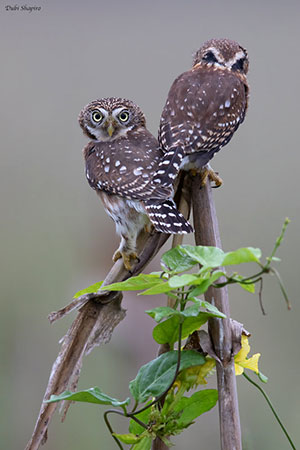
The brown morph adult is similar, with dark brown coloration instead of dark greyish-brown.
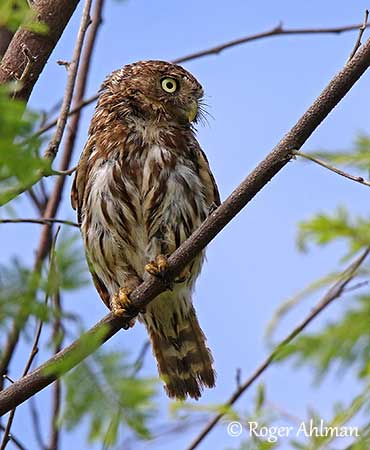
The rufous morph adult has rusty-brown upperparts. The rufous tail shows less distinct orange-buff to rusty-brown bars. The pattern of the underparts is less distinct than in other morphs.
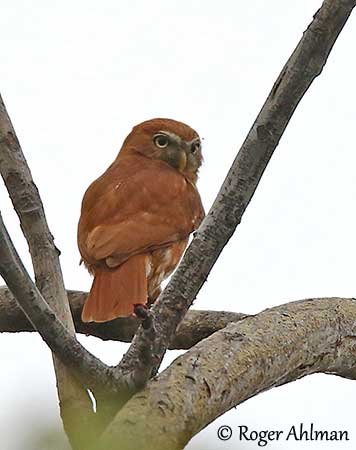
Male and female have similar appearance but the female is slightly larger than the male.
The juvenile has unspotted crown.
The grey morph is usually found at high elevation and usually shows white spots of various sizes on the crown.
The birds living at lower elevation have mainly whitish to pale buff shaft-streaks and drop-shaped spots on the crown.
RANGE:
The Peruvian or Pacific Pygmy-Owl is found in W Ecuador, S through W Peru to N Chile. It also occurs E of the Andes in extreme SE Ecuador and Marañon drainage of Peru.
HABITAT:
The Peruvian or Pacific Pygmy-Owl frequents deciduous and riparian forests, semi-arid bushland and thorny scrubs with cacti and scattered trees, agricultural areas with large trees, and locally urban parks.
The species can be seen from sea-level up to foothills at 3,300 metres of elevation in Peru. In Chile, it is found up to 3,500 metres, whereas in Ecuador, it is present from 1,200 to 2,400 metres.
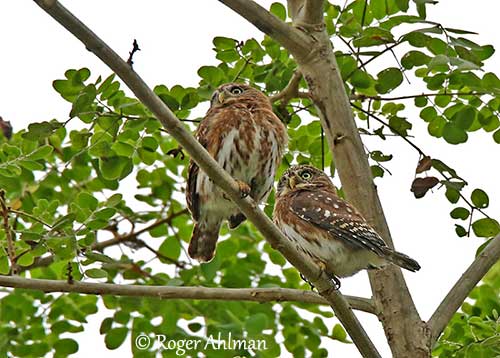
CALLS AND SONGS: SOUNDS BY XENO-CANTO
The Peruvian or Pacific Pygmy-Owl male’s song is a very rapid series of short, staccato notes, about 6-7 per second. It is described as “toitoitoitoitoitoitoitoit”. This sequence often varies in length and is usually repeated at short intervals.
The female’s song is slightly higher-pitched.
These sounds are typical of this species and allow to identify it.
When excited, the bird gives high-pitched, short “kee” notes, sometimes in series of 5-10 with short intervals “kee kee kee kee” ending in abrupt, sharp “kip kip kip kip”.

BEHAVIOUR IN THE WILD:
The Peruvian or Pacific Pygmy-Owl feeds on insects and various arthropods, and also takes small birds. However, depending on the location, it may also catch small mammals and other small vertebrates.
It hunts from perch in middle storey and canopy.
It is active by day but mainly at dusk, and also on clear nights. The species is known to enter the nests of Furnariidae (ovenbirds) to kill and eat the chicks.
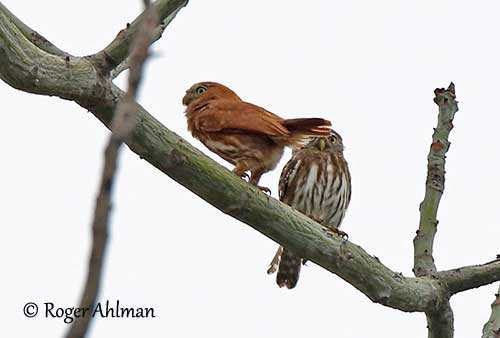
The breeding behaviour of the Peruvian or Pacific Pygmy-Owl is poorly known. The male is very territorial and defends the territory. It may attack intruders by plunging towards them.
The species is a cavity-nester, using various holes or abandoned nests of woodpeckers.
The Peruvian or Pacific Pygmy-Owl is probably resident throughout the range.
It only moves over short distance with undulating flight.
REPRODUCTION OF THIS SPECIES:
The reproduction of the Peruvian or Pacific Pygmy-Owl is little studied.
It is a cavity-nester and usually nests in holes in trees, walls or river banks. It also uses abandoned woodpecker’s holes, and may occasionally nest in mud nest of ovenbird placed on tree branch.
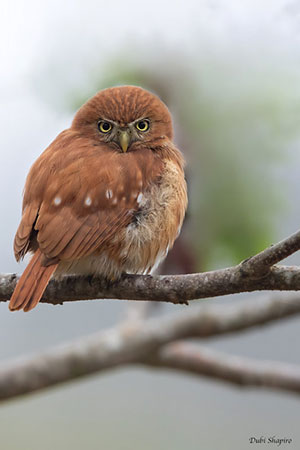
The female incubates alone the white eggs. In other species of genus Glaucidium, the male feeds the female during the incubation. At hatching, the chicks have white down overall.
No other information.
PROTECTION / THREATS / STATUS:
The Peruvian or Pacific Pygmy-Owl is described as “common” in Ecuador, and “fairly common to common” in Peru.
The species is not affected by human activities, as long as cavities are available.
The population is suspected to be stable and not globally threatened.
The Peruvian or Pacific Pygmy-Owl is currently evaluated as Least Concern.
